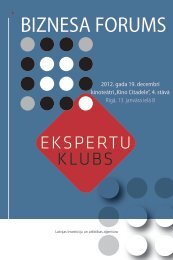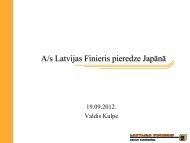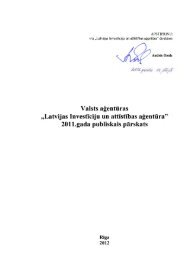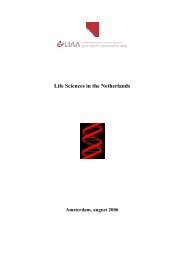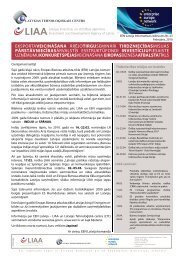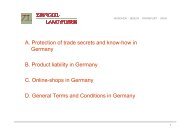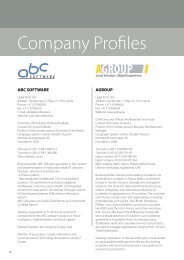Standard and Pallets - LIAA
Standard and Pallets - LIAA
Standard and Pallets - LIAA
- No tags were found...
Create successful ePaper yourself
Turn your PDF publications into a flip-book with our unique Google optimized e-Paper software.
D-packsThe following is an overview of the labelling of product information on D-packs:InformationHuman readabletextEAN/UCC 128(bar code)AIFormatEAN Article Number Must be labelled Must be labelled 01 n2 + n14for D-packName of br<strong>and</strong> owner Must be labelled No labelling requiredArticle description Must be labelled No labelling requiredBatch or lot number 1) Must be labelled Must be labelled 10 n2 + an..20Best before date 2)Net weightSupplier’s articlenumberMust be labelled ifconsumer unit has abest before dateMust be labelled forproducts with variableweightsMay be labelled1)Batch or lot no. can be omitted for the product by agreement between the parties. See Appendix 3.Must be labelled ifconsumer unit has abest before dateMust be labelled forproducts with variableweightsNo labelling required15 n2 + n63103 n4 + n62)Alternatively, the last “sell by” date (EAN/UCC 128 AI 17) can be used to indicate durability.1.4. Guidelines for labelling D-packs1.4.1. Type of bar code symbolWhen bar coding D-packs, the bar code symbol EAN/UCC 128 must be used, with reference to thetraceability requirements. For D-packs, alternative labelling can be agreed bilaterally between thesupplier <strong>and</strong> retailer (see Appendix 3).1.4.2. Various informationThe same information (AI) may appear only once per label.1.4.3. Quality, size <strong>and</strong> design of labelsSince the shape <strong>and</strong> size of D-packs will vary greatly, the size <strong>and</strong> design of the labels may also vary.A requirement is that the print quality of EAN/UCC 128 bar codes shall at least satisfy ISO/IEC st<strong>and</strong>ard15416, Grade C. The labels must be readable at all levels.5
2. <strong>Pallets</strong>2.1. Two types of palletsIn this specification we distinguish between two types of pallets, depending on the contents of the unit.• <strong>St<strong>and</strong>ard</strong> pallet. Unit containing the same product (same GTIN) with a fixed number of D-packs<strong>and</strong> where the pallet can be labelled with unambiguous product information. For production reasons,it may be the case that a st<strong>and</strong>ard pallet contains the same type of product, but with a differentbatch/lot number <strong>and</strong>/or best before dates. This is a deviation from the main rule, <strong>and</strong> must be agreedbilaterally between the parties.• Mixed pallet. Unit containing different products or where the pallet cannot be labelled withunambiguous product information.<strong>St<strong>and</strong>ard</strong> pallet<strong>St<strong>and</strong>ard</strong>pallMixed pallet<strong>St<strong>and</strong>ard</strong> pallets are labelled with both product <strong>and</strong> transport information. Since the productinformation <strong>and</strong> transport information are as a rule known at different times, the practical solution isto mark the unit with two different labels:1. Label containing product information (including SSCC code)2. Label containing transport informationMixed pallets are marked with only one label type. No product information is included, only transportinformation, including the SSCC code.If all the information is known at the time the pallet is labelled, all the information can be providedon one label.The labelling of pallet display units is described in Appendix 1.2.2. Labelling product informationThis section specifies current product information for labelling st<strong>and</strong>ard pallets. This information willnormally be included in what in this specification is termed an EAN Product Label (see example oflabel in Section 2.6.). Note that this section does not apply to mixed pallets.2.3. SSCC codeThe SSCC code (Licence Plate EAN/UCC 128 AI 00) must be labelled on each individual pallet inhuman readable text <strong>and</strong> with a bar code. The SSCC code identifies the individual pallet. Note thatif both a product label <strong>and</strong> transport label are used, the SSCC code can be given on both labelsprovided exactly the same code is used.8
<strong>Pallets</strong>The bar code with the SSCC code should be printed on the bottom line of the bar codes. It isrecommended that only the SSCC code be placed on this line (no concatenation).2.4. GTIN - Global Trade Item Number (EAN Article Number)<strong>Pallets</strong> must always be labelled with the EAN Article Number (GTIN). There are several ways of doing this:• Primarily, the EAN Article No. for D-packs must be used (EAN/UCC 128 AI 02), <strong>and</strong> the number ofD-packs on the pallet must also be stated (EAN/UCC 128 AI 37).• The pallet’s own unique EAN Article No. can also be stated (EAN/UCC 128 AI 01).• If the whole pallet is defined as a D-pack, the EAN Article No. for this D-pack (pallet) must be used(EAN/UCC 128 AI 01). In that case, the number of D-packs on the pallet should not be stated.2.5. Article descriptionThe article description of the product must appear in human readable text on the pallet’s product label.The article description shall be based on the article description in the EPD database which consists ofproduct name, properties <strong>and</strong> br<strong>and</strong> description. The article descriptions that are marked on palletsmust align with the article descriptions in the despatch advice <strong>and</strong> invoice.2.6. Further product informationSupplementary product information can or should include the following:Batch or lot no 1) (EAN/UCC 128 AI 10) is generated by the manufacturer <strong>and</strong> is used to trace theproduct back to a specific production series.Best before date 2) (EAN/UCC 128 AI 15) must be labelled on all pallets that have a “Best before” dateapplied to Consumer Units (CU).Net weight (in grams - EAN/UCC 128 AI 3103) must be labelled on variable measure products. Netweight signifies the weight of the product excluding packing (the weight invoiced for).Gross weight (in kg) must be labelled in human readable text on each individual pallet. Gross weightis defined as the weight of the product including packing <strong>and</strong> pallet (load carrier).Max. stacking weight (in kg) must be labelled in human readable text.Ref. STAND 006.Temperature requirement must be labelled in humanreadable text where the product has a temperaturerequirement.1) Where the batch/lot no. is omitted on the D-pack, it can also be omitted on the pallet.2) Alternatively, the last “sell by” date (EAN/UCC 128 AI 17) can be used to indicate durability.9
<strong>Pallets</strong>The product information labelling guidelines can be summarisedas follows for <strong>St<strong>and</strong>ard</strong> <strong>Pallets</strong>:Information Human readable text EAN/UCC 128AI Format(bar code)SSCC codeMust be labelled Must be labelled 00 n2 + n18(Licence Plate) 1)EAN Article No. for Can be labelled Can be labelled 01 n2 + n14pallet 2)EAN Article No. forD-pack in the palletMust be labelled Must be labelled 02 n2 + n14Number of D-packs inpalletMust be labelledexcept when pallet isdefined as a D-packMust be labelledexcept when pallet isdefined as a D-packArticle description Must be labelled No labelling required37 n2 + n..8Batch or Lot No. 3) Must be labelled Must be labelled 10 n2 +an..20“Best before” date 4)Net weightMust be labelled ifCU has printed “bestbefore” dateMust be labelled ifvariable measureproducts are includedMust be labelled ifCU has printed “bestbefore” dateMust be labelled ifvariable measureproducts are included15 n2 + n63103 n4 + n6Gross weight Must be labelled Can be labelled 3300 n4 + n6Max. stacking weight Must be labelled No labelling requiredTemperaturerequirementMust be labelledif the product hasa temperaturerequirementNo labelling required1) The SSCC code should be given on the product label, but can be used on both labels providing exactly the same code is used.2) May be used in a transition period in special cases.3) Where the batch/lot no. is omitted on the D-pack, it can also be omitted on the pallet.4) Alternatively, the last “sell by” date (EAN/UCC 128 AI 17) can be used to indicate durability.10
<strong>Pallets</strong>Example of EAN product label for st<strong>and</strong>ard palletManufacturer’s name/logoFrozen peasGTIN (EAN article no.) No. of D-packs 407012345000013 Temp. requirement -18°CBest beforeTolerate 460 kg top load31.12.2007 Gross weight 460 kgSSCC codeBatch no. 12345XF37012345123456789211
3. Labelling transport informationThis section specifies current transport information for labelling pallets.3.1 Transport label for st<strong>and</strong>ard palletsWith regard to <strong>St<strong>and</strong>ard</strong> <strong>Pallets</strong>, the SSCC code is marked on the EAN Product Label (see Section 2.3).Note that where both the product <strong>and</strong> transport label are used, the SSCC code can be marked on bothlabels provided that exactly the same code is used.Shipper’s name, address etc. The pallet must be marked with the shipper’s name, street address,post code <strong>and</strong> town in human readable text.Consignee’s name, address, etc. The pallet must be marked with the consignee’s name, streetaddress, post code <strong>and</strong> town (the delivery address) in human readable text.Customer’s reference. The pallet must be marked with the customer’s reference number (e.g.customer’s purchase order number). More than one reference may be given.Dispatches via cross docking terminal:Name, address etc. of cross docking terminal. The pallets should be marked with the name ofthe cross docking terminal, street address, post code <strong>and</strong> town. These details should appear in the“via” field.The following is an overview of transport labels for labelling st<strong>and</strong>ard pallets:Information Human readable text EAN/UCC 128(bar code)Shipper’s name, street address,post code/townConsignee’s name, street address,post code/townName, address etc. of crossdocking terminalMust be labelledMust be labelledTo be labelled when thedelivery goes via crossdocking terminalNo labelling requiredNo labelling requiredNo labelling requiredCustomer’s reference Must be labelled No labelling requiredSSCC code (Licence Plate) 1) No labelling required No labelling required1) SSCC code should be given on the product label, but can be used on both labels providing exactly the same code is used.12
Labelling transport informationExample of EAN transport label for st<strong>and</strong>ard palletsFromEAN NORGESpireaveien 60513 OSLOToGrossist ASSeljeveien 63940 PORSGRUNNViaCoop Norge SentrallagerØstre Aker vei 2640977 OSLOCustomer’s reference: 123453.2 Transport label for mixed palletsThe SSCC code (Licence Plate EAN/UCC 128 AI 00) must be labelled on each individual pallet inhuman readable text <strong>and</strong> with a bar code. The SSCC code identifies the individual pallet (see Section2.3).Shipper’s name, address etc. The pallet must be marked with the shipper’s name, street address,post code <strong>and</strong> town in human readable text.Consignee’s name, address, etc. The pallet must be marked with the consignee’s name, streetaddress, post code <strong>and</strong> town (delivery address) in human readable text.For dispatches via the cross docking terminal:Name, address, etc. of cross docking terminal. <strong>Pallets</strong> should be labelled with the cross dockingterminal’s name, street address, post code <strong>and</strong> town. These details should appear in the “via” field.Customer’s reference. The pallet must be labelled with the customer’s reference number (e.g. thecustomer’s purchase order number).Gross weight (in kg) must be labelled in human readable text on each individual pallet. Gross weightis defined as the weight of the product including packing <strong>and</strong> pallet (load carrier).Temperature requirement must be labelled in human readable text if the product has a temperaturerequirement.13
Labelling transport informationThe following is an overview of transport labels for labelling mixed pallets:Information Human readable text EAN/UCC 128(bar code)Shipper’s name, streetaddress, post code,townConsignee’s name,street address, post code,townName, address etc. ofcross docking terminalMust be labelledMust be labelledMust be labelled whenthe delivery goes via thecross docking terminalNo labelling requiredNo labelling requiredNo labelling requiredCustomer’s reference Must be labelled No labelling requiredAIFormatGross weight Must be labelled Can be labelled 3300 n4+n6Temperature requirement Must be labelled No labelling requiredSSCC code (Licence Plate) Must be labelled Must be labelled 00 n2+n1814
Labelling transport informationExample of EAN transport label for mixed palletsFromEAN NORGESpireaveien 60513 OSLOToGrossist ASSeljeveien 63940 PORSGRUNNViaCoop Norge SentrallagerØstre Aker vei 2640977 OSLOCustomer’s reference 12345Gross weight 460 kgTemperature requirement – 18 CSSCC code 37012345123456789215
4. Guidelines for labelling pallets4.1 Location of labels on palletsIn accordance with this st<strong>and</strong>ard, two types of labels must be used; labels for product information <strong>and</strong>labels for transport information.• The minimum requirement is that the pallet must be labelled on two sides with both types oflabel, more specifically the short side <strong>and</strong> the long side on the right-h<strong>and</strong> side (viewed from theshort side).• The product <strong>and</strong> transport labels must be on the same sides.• If two labels are used on the same side of the pallet, they must be positioned vertically beneath oneanother. The label containing the SSCC code must be placed at the bottom.• The label must be placed so that the bottom edge of the lowest bar code is at least 400 mm abovethe floor, <strong>and</strong> so that the top edge of the uppermost bar code is no more than 800 mm above thefloor. The label must also be placed at least 50 mm from the vertical side. If a pallet is less than 400mm high, labels must be placed as high as possible.• If all the information is known at the time the unit is labelled <strong>and</strong> there is sufficient space on thelabel, all the information may be printed on the same label.4.2. Various informationThe same information (AI) may appear only once on the product label <strong>and</strong> transport label. In practicethis means that the same information can neither be repeated on the same label nor can they appearon more than one label on the unit (pallet). The exception to this rule is the SSCC code, which ispermitted on both labels provided exactly the same code is used.4.3. Quality, size <strong>and</strong> design of labelsThe following recommendations apply:• The width of the label must be 105 mm or 148 mm• The height of the label may varyCurrent formats are:• A5 (148 mm x 210 mm)• A6 (105 mm x 148 mm)• 105 mm x 192 mmA requirement is that the print quality of EAN/UCC 128 barcodes shall at least satisfy ISO/IEC st<strong>and</strong>ard 15416, Grade C.The labels must be readable at all levels. When placing thelabels it is important to ensure that the bars in the EAN/UCC 128 symbol are linear <strong>and</strong> unbroken (avoid wrinkleson the label).16
Guidelines for labelling pallets4.4. Bar codesWith regard to bar code labelling with EAN/UCC 128, reference is made to the General EAN/UCCSpecification in Section 5.3. We draw particular attention to the following:• The magnification factor is in the interval between 50% <strong>and</strong> 94% of nominal size.• The minimum height of the bar code is 32 mm.• When labelling the GTIN (AI 01 <strong>and</strong> AI 02) 14 digits must always be used. When GTIN has 13 digits,a leading zero must be added (e.g. 07038010000065).• For bar code labelling in EAN/UCC 128, an indicator known as Function Code 1 (FNC1) is usedbetween the individual pieces of information. This applies in all cases except for the AIs, which havea pre-defined fixed length. The following AIs in this document have a pre-defined length: AI 00, AI01, AI 02, AI 15.• It is recommended to have the AI that will be succeeded by FNC1 at the end of the bar code line,since then the FNC1 can be omitted.• It is important to fulfil the requirements for light margins. For magnification factor 50%, the left <strong>and</strong>right light margins are 5 mm, <strong>and</strong> for 94% they are 9.4 mm.17
Appendix 1Labelling pallet display units with SSCC codeThe main rule is that a pallet display unit is labelled as one D-pack that contains a fixed number of consumer units.Some retailers require pallet display units to be marked with anSSCC code.This type of labelling must be agreed bilaterally with the partiesthat require this.Per definition, this pallet display unit applies in the form of 1/4,1/3 <strong>and</strong> 1⁄2 pallets (calculated as area) which each have their loadcarriers, <strong>and</strong> are built up on a Euro pallet which further makes upa transport unit. There is a limited number of suppliers, mainlyNorwegian, who operate with this type of pallet display unit. 1)1)When pallet display units are included in a transport unit both the pallet display units <strong>and</strong> transport unit must be labelled with SSCC codes.This entails a supplement to the D-pack label <strong>and</strong> use of electronic despatch advice (DEDIP2 DESADV ) level 4.18
D-pack label with SSCC code for pallet display unitsThe label for pallet display units has the same information content as a normal D-pack label but withthe addition of the SSCC code. The pallet labels are unchanged (see Sections 2 <strong>and</strong> 3). For a descriptionof the SSCC codes, see Section 2.3.Manufacturer’s nameLogo etcFrozen chops6 units X 500 gramGTIN (EAN article no)7012345000013Best before31.12.2007SSCC code370123450000001004Supp. article no.500001Batch no.12345XFDEDIP2 DESADV (despatch advice) for pallet display unitsDEDIP2 DESADV for pallet display units entails a level 4 for the despatch advice. On the line levelfor pallet display units, an SSCC code must be given for each pallet display unit (level 4 of despatchadvice). See the user profile for DEDIP2 Despatch advice (can be downloaded from www.ean.no).19
Appendix 2Labelling customer-packed deliveries from supplier(cross docking)This applies to labelling with SSCC codes on to unit levels when customer-packed units are includedin a transport unit. This entails separate labelling of the customer-packed unit <strong>and</strong> the use of electronicdespatch advice (DEDIP2 DESADV ) level 4.Per definition this applies to customer-packed units that do not need to have their own load carriers,<strong>and</strong> are built up on a st<strong>and</strong>ardised transport unit (e.g. Euro pallet).A transport unit with customer-packed units is separated upon receipt at the distribution warehouse,<strong>and</strong> the individual customer-packed unit is forwarded to retail outlets/final recipient. It is a prerequisitethat all customer-packed units that are located on the same pallet are going to the same distributionwarehouse.Transport label for palletsThe pallets are labelled with a transport label in a similar way to the mixed pallets.The shipper, consignee <strong>and</strong> any via address are specified here. Consignee is defined here as thedistribution warehouse where the pallet is separated <strong>and</strong> the customer-packed units are forwarded tothe respective final recipients.Note that if the whole pallet is going to the same final recipient, this pallet is labelled as for customerpackedunits.20
Transport label for pallets consisting of customer-packedunitsFromGilde ANSLørenveien 350585 OSLOToASKO VestS<strong>and</strong>brekkeveien 955224 NesttunViaJoh. SystemNedre Kalbakkvei 220950 OsloCustomer’s reference 12345Gross weight 460 kgTemperature requirement – 18 CSSCC code 370123451234567892Transport label for customer-packed unitThe customer-packed unit is labelled with a transport label containing the following information:• The supplier is given as the shipper.• The final recipient/final delivery address is given as the consignee.• It is recommended to give the distribution warehouse where the pallet will be separated/crossdocked in the “via” field.• A separate field is given on this label for transport information. This is information that the customersends to the supplier in his order, <strong>and</strong> which the supplier must print on the label for customerpackedunits. The format <strong>and</strong> content in the transport information is agreed between the parties.21
Transport label for customer-packed unitFromGilde ANSLørenveien 350585 OSLOToMeny NesttunNesttunveien 905221 NesttunViaASKO VestS<strong>and</strong>brekkeveien 955224 NesttunTransport informationDeparture Loading area Departure time1:1001 U-1/Nord Man 06.06 12:00Customer’s reference 12345Gross weight 460 kgTemperature requirement – 18 CSSCC code 37012345123456789222
DEDIP2 DESADV (despatch advice) for customer-packed unitsFor DEDIP2 DESADV for customer-packed units level 4 is used.The despatch advice message only contains the delivery of the same distribution warehouse, i.e. wherethe pallets are separated for forwarding of retail outlet-packed units.The message is structured as follows:Shipper <strong>and</strong> consignee (distribution warehouse) are given in the header of the message. The pallets’SSCC codes are given in the normal way (GIN gr. 14).The content of each individual customer-packed unit is given on the line level. The SSCC code <strong>and</strong>GLN (EAN Location Number) for the final recipient are given as supplementary information on theproduct line, <strong>and</strong> repeated for each product that is included in the customer-packed unit.23
Appendix 3Alternative labelling of D-packsFor labelling of D-packs (Trading Units) <strong>and</strong> pallets (TransportUnits), the main rule is that EAN/UCC 128 must be used.Where a supplier finds that such labelling is difficult due topractical, financial or organisational reasons, or because decisionson labelling are part of the company’s international strategy <strong>and</strong>practice, this can be taken up with the customers. With a welldocumented basis by the supplier, the retailers will be positive tobilateral agreements where it is sufficient to label D-packs withEAN 13 or EAN 14 (ITF 14).In these cases, it is assumed that it is not necessary to label D-packs with a batch/lot number or best before date.Example:Manufacturer’s nameLogo etcSteel wool6 units X 100 gramGTIN (EAN article no.)7012345000013Supp. article no.50000124
Appendix 4Description of correlation between labelling concept <strong>and</strong>electronic despatch advice level 3In DEDIP2 Despatch advice level 3, also known as ASN (Advanced Shipping Note), the SSCC code isused in order to uniquely identify each individual pallet , <strong>and</strong> this SSCC code is the main key in thedespatch advice. It is also specified at line level which D-packs the pallet consists of. The number ofD-packs <strong>and</strong> the batch/lot number, <strong>and</strong> – if available - best before date are given at D-pack level.The supplierWhen the pallets are built by the supplier, each pallet is assigned a unique SSCC code.This takes place during production for st<strong>and</strong>ard pallets, <strong>and</strong> the following information is linked to theSSCC code in the supplier’s ERP system:• GTIN 1) of D-pack• No. of D-packs• Article description• Batch/lot number• Best before dateFor mixed pallets, product picking <strong>and</strong> building of pallets will mainly be linked to a specific customerorder. The same information as for st<strong>and</strong>ard pallets (see above) will be linked to the unique SSCC codefor the mixed pallet.When the supplier receives an order from the customer (the retailer), the following information will belinked to the relevant order:• Customer’s reference (the customer’s PO number)• SSCC codes for st<strong>and</strong>ard pallets <strong>and</strong> mixed pallets with associated product information (seeabove)• GLN 2) for the supplier (seller, pick-up point)• GLN 2) for the customer (customer, delivery address, or cross docking terminal)Upon shipment, the supplier will send an electronic despatch advice (DEDIP2 DESADV level 3) to thecustomer. It is then the SSCC codes on the st<strong>and</strong>ard pallets <strong>and</strong> mixed pallets that link the physicaldelivery to the content of the electronic despatch advice.The supplier has thus full control of the shipment with regard to traceability, since his ERP system haslinked together the product’s GTIN <strong>and</strong> batch/lot number with the SSCC code for the pallet containingthe product, <strong>and</strong> for the delivery address to which it is sent.1)GTIN (Global Trade Item Number) is a collective term for EAN’s different number systems for article identification (covers EAN 8, UPC 12, EAN 13 <strong>and</strong>EAN 14).2)GLN (Global Location Number) is defined as the EAN Location Number.25
The customerWhen the pallets arrive at the distribution warehouse, it is a requirement that the customer has alreadyreceived the electronic despatch advice.Upon receipt, the SSCC codes on the st<strong>and</strong>ard <strong>and</strong> mixed pallets are scanned. An entry against theelectronic despatch advice is then made, <strong>and</strong> a check can be made that the relevant pallet containsthe specified products. The stock is updated based on information in the despatch advice. Thus, thereis no need to scan each D-pack.In this way, the customer has full control with regard to traceability from his suppliers, since his ERPsystem links together the product’s GTIN <strong>and</strong> batch/lot number with the SSCC code for the palletwhere the product is located, <strong>and</strong> from which supplier it has been received.26
Appendix 5ReferencesDLFDMFSTANDwww.dlf.nowww.dmf.nowww.st<strong>and</strong>.noBest practice for tracking, withdrawing <strong>and</strong> recalling in the Norwegian grocery sectorhttp://www.st<strong>and</strong>.no/filestore/Heledokumentet.pdfEAN NORGE www.ean.no<strong>St<strong>and</strong>ard</strong> for labelling D-packs <strong>and</strong> pallets in the Norwegian Grocery Sector version 4.0DEDIP2 Despatch AdviceGeneral EAN/UCC Specification – Section 5.327




